
by David McGuffin | Jun 29, 2016 | Blog, Essential Travel Resources
Everybody goes on vacation from time to time. For some it is the payoff for a year of toil. For others, it is an adventure that was years in the making. Whether you are looking to let off a little steam or you are an adrenaline junkie looking for your next fix, the difference between a good vacation and a nightmare all comes down to choosing the right travel agent and tour operator.
For this article, I’ll use the terms travel agent and tour operator in much the same context. In fact, let’s just call them travel providers, however, there is a difference. Typically, a travel agent provides a varied selection of travel services to the public such as: airline tickets, hotel accommodations, automobile rentals, river and ocean cruises, packaged tours and much more. Think of them as your one-stop shop for all your travel needs. Tour operators, on the other hand, specialize in one particular tour product or destination. These can include destination specific tours, cruises, adventure travel, group tours, themed tours, and much more. For example, our company, David McGuffin’s Exploring Europe, is a tour operator specializing in European small group and independent travel.
The first thing you have to understand is the travel business is so large that there is no single agent, operator or travel provider that can plan the perfect vacation to all parts of the globe. Today, travel providers are a lot like doctors… they specialize in one area. Some travel providers are experts in booking cruises, while others specialize in group tours and independent travel. However, even within these areas of specialization, no two travel providers have precisely the same experience. What this means is that unless you want to roll the dice and take your chances on picking an agent or tour operator that can either make or break your vacation, you need to understand how to weed them out.
Good Travel Providers
Begin your search for travel expert by realizing that the lowest price doesn’t always represent the best value. So using online portals such as Travelocity. Orbitz and Priceline isn’t where you should start your search, unless price is your only consideration. Think of a good travel provider as a consultant. He or she has spent years learning about the industry and what it represents to clients. A good travel provider has had experience working with hundreds or even thousands of travelers and many destinations as well. They have been in the game long enough to know what hotels and tour activities are up to snuff and which are not. They have had to make a call in the dead of night to straighten out a client’s lost reservation or missed connection. They form a bond with clients that transcends a mere pay-for-hire relationship.
Make no mistake about it, the bond between a travel provider and a client should not be taken lightly. Just as with any other business, good and bad reviews can make or break a travel provider’s reputation. This is also a reason why you should always perform a web search of any travel provider with which you are considering doing business. Any travel provider worth their salt will have reviews online. Start off by going to the search engine of your choice and typing in the name of the travel provider followed by the word “reviews.” You’d be surprised what you can find out with a web search.
Next, go to the travel provider’s website in order to look for blogs, videos and testimonials. This will also provide you with insight regarding the travel provider’s experience and areas of specialization. Do the tours posted look like something that you and your family would enjoy? Are the prices a good fit for your budget, or are they out of your league.
Last but not least, pick up the phone and give them a call. Personality as well as experience plays a big part in choosing the right travel provider. In fact, that is the primary reason to work with a particular travel provider. No matter how good of a deal the website promotes, if you feel that the agency is either too inexperienced, or too busy to deal with your wants and needs, look elsewhere. That’s also a reason to avoid making your decision based entirely on price. Speaking of price, don’t believe that working with a travel provider is going to cost you more than booking a trip on your own. Far from it. Since good agencies have many contacts in the industry, they can many times save you money since they receive information that is not posted to the general public. (That being said, when dealing with a travel agent, you’ll want to make sure to understand any commissions or booking fees related to your trip.)
Bad Travel Providers
Bad travel providers either don’t know or they don’t care. This means that they either have had little experience and connections in the industry, or they are simply a gun for hire that is more interested in selling tours and travel products than building a lasting relationship with clients. While a number of travel providers are overworked and underpaid, what’s even worse is when a travel provider is a crook.
In a quote from an article on frommers.com entitled, “9 Ways to Tell if Your Travel Agent is Crooked,
“As a rule, most travel agents are well-trained, competent professionals who work hard for you. But there are exceptions to every rule. Take Kathleen Rossano of East Brunswick, N.J., who was recently sentenced to a 10-year prison term for stealing more than $75,000 from her travel agency. Prosecutors had charged her with offering luxury vacations to her friends, taking cash payments, billing the expenses to her agency’s credit card and then pocketing the money. It was the fourth time she’d been convicted of taking money from former employers.A month later, her former agency, Cruise Value Center, collapsed without paying the cruise lines what they were owed and leaving customers in the lurch. One of the clients recently contacted me in a panic after her cruise line demanded an additional payment of $2,544 for her vacation because the cruise line had been stiffed by the agency.” http://www.frommers.com/tips/money-and-currency/9-ways-to-tell-if-your-travel-agent-is-crookedHow many of her clients do you think were lured in by low prices posted on her website? When it comes to crooked agents and thieving tour operators, how hard do you think it is to set up a website that makes offers that are too good to be true, only to take the money and run? That’s one of the reasons you need to check out any agency before you lay down your hard earned money. The Frommers article goes onto provide readers with the following 9 warning signs pointing to a terrible tour provider:
1. Demands you pay in cash,2. Acts funny when you bring up commissions,3. Adds a booking fee to your bill after you’ve decided to buy a vacation,4. Has no certification,5. Doesn’t know a thing about the place you are going to visit,6. Has a Better Business Bureau rap sheet,7. Is impossible to reach,8. Doesn’t listen,9. I bought my agency certification online for a few hundred bucks!
“Studly” Travel Providers
The best travel providers stand out from the crowd. They are not merely knowledgeable about a destination, they are experts. They have been to the places to which you are looking to travel and know the lay of the land. They can not only describe the places you are going to see, but they can tell you about some of the people you will meet. Some travel providers will not only book a cruise or tour, but lead it as well. They will be there to make sure that nothing goes wrong. When it comes to getting the most out of a trip, having an experienced travel provider and tour guide can make all the difference in the world. Working with a superstar agency may cost a bit more, but when you consider that a vacation comes but once a year, travel satisfaction is priceless.
To summarize, there are good, bad and “studly” tour providers. Commonly, these consist of both travel agents and tour operators. A good tour provider knows its clients, is an expert in its destinations, offers stellar customer service, has good online reviews, is well respected in the community and offers a good value for the tour experience. Bad tour providers are interested solely in selling a product, often have little or no experience in their tour destinations, may have poor online reviews and an extensive Better Business Bureau “rap sheet” and typically, are not certified or licensed. The “studly” tour provider is a trusted friend who provides stellar customer service, fantastic travel opportunities and is an expert in their specialized destinations.
If you found this article informative, please share it with your friends, family, coworkers and associates. If you have something to add, just leave a comment in the box below.
Do you want to learn more about traveling in Europe? There is a wealth of information and special discount pricing at my website. Visit now at https://davidmcguffin.com/.
David McGuffin is Founder and CEO of David McGuffin’s Exploring Europe, Inc., based in Middleburg, Florida. You can connect with him on Twitter, Facebook, Google+, LinkedIn and YouTube. David spends his time in Europe organizing and leading small group and independent tours to European destinations. In business since 2001, David has provided exceptional travel opportunities to several thousand satisfied customers. You can find out more about David and his European tours at his website, https://davidmcguffin.com.

by David McGuffin | Aug 4, 2014 | Blog, David's Journal, Experiencing Europe
Enjoying the opportunity to sleep in!
We slept in this morning, knowing there would be plenty of time to explore Athens in the next few days. After breakfast, Charlotte and I checked out of the Electra Hotel and walked five blocks to their sister hotel, The Electra Palace. Normally, I do not change accommodations, but we are booking this trip as we go, not knowing from day-to-day what the next one holds.
The Electra Palace
 The Electra Palace has one benefit over the Electra Hotel and that is its rooftop pool with grand views of the Acropolis. We are paying premium prices for our room here, but the benefit of having an “oasis” in the heart of Athens, plus the rooftop pool makes it a worthwhile expense.
The Electra Palace has one benefit over the Electra Hotel and that is its rooftop pool with grand views of the Acropolis. We are paying premium prices for our room here, but the benefit of having an “oasis” in the heart of Athens, plus the rooftop pool makes it a worthwhile expense.
Our tour “group” grows…
Our friend, Janey, arrived in Athens earlier this morning and was waiting for us in the hotel lobby. As expected, our rooms were not ready, so we gave the hotel a “once over” and headed up to the rooftop pool and bar area. We took a seat, with the Acropolis hovering over us in the distance, and sketched out a rough plan for our adventure in Greece.
I had been to Athens on three previous occasions, the first in 1977 (which I will continue to reference here in my writings), the second in the summer of 2006, and the last in December 2010. But beyond Athens (and the island day trips to Aegina, Porous, and Hydra), it is all going to be a new adventure. Our rough planned itinerary looks likes this: Athens, Delphi, Olympia, the Mani Peninsula, Napflio, and the island of Santorini.
A lazy afternoon at the pool…
Later, we checked into our rooms and while Janey napped off her jetlag, Charlotte and I changed into our bathing suits and headed to the pool. We enjoyed a relaxed lunch, cool dips in the pool, and great views of the Acropolis. We were so close I could see weary and over-heated tourist walking on the Acropolis, frantically trying to fit their sightseeing in during the hottest part of the day.
Me and my journal…
I became faithful with my journal entries in the summer of 1997. Since then, I’ve kept a pretty good record of things happening in my life and especially my travels. Over the years, my journal has become a companion and a place to escape, especially when traveling alone with no one to talk to. I enjoy putting my thoughts to paper and sketching. This afternoon, I tried to capture the mood and feel of the Acropolis with this sketch.
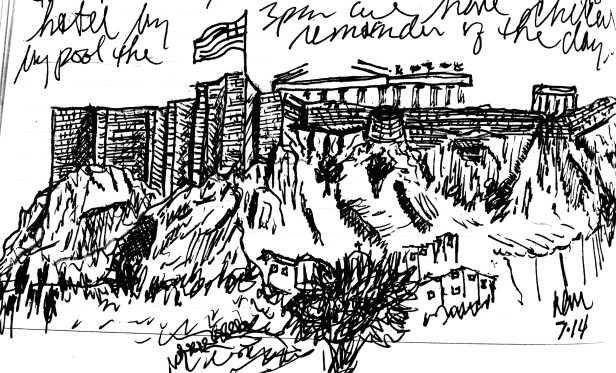
Sightseeing in the Plàka
Along about 5:30 p.m., we headed out for our sightseeing in the Plàka neighborhood. It was still hot and we stuck to the shady sides of the streets as we wound through the shopping streets, narrow lanes, past Byzantine-era churches, and the tourist oriented shops.
Ermou Street
Ermou is the main street leading from Sytagma Square into the Plàka. It once was filled with filth, loud traffic, and ugly signs. Since 2000, it has become a pedestrian-only area and both tourists and locals enjoys a stroll in this shopping oriented street.

Ermou Street
The Church of Kapnikarea
Athens was once a part of the vast Byzantine Empire which controlled much of Europe from A.D. 323-1453. This church, the Church of Kapnikarea, is a classic example of an 11th century Byzantine house of worship. Notice the classic Byzantine architectural designs including a red-tiled domed cupola topped with a cross and narrow and tall arched windows often with diamond-shaped trim.
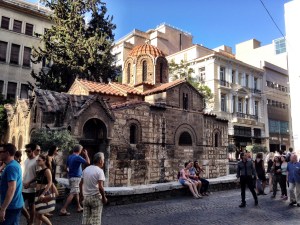
The Church of Kapnikarea
Athen’s Cathedral
This church was built in 1842 and looks much worst for wear than other churches in the area dating from 600 years before! However, it is Athen’s most important Greek Orthodox church and the “head” church of the Greek Orthodox faith. It is in dismal condition! The interior and exterior are covered with scaffolding and shrouded in construction cloth. The placard outside does list a schedule of worship services… but ughh… I can’t imaging it here.

Athens Cathedral
Adrianou Street
This IS souvenir street! Adrianou Street runs from near the new Acropolis Museum, heads north, and then turns west to follow the lays of the Acropolis hill. For me, it is the “main drag” offering all the “Greek” trinkets and souvenirs. You’ll find it all… olive oils, olive wood, worry beads, jewelry, leather sandals, sponges, Pandora beads, Greek replica statues, t-shirts, and tons of stray cats!
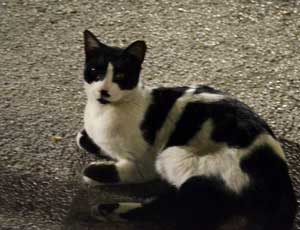
Hello kitty
The Roman Forum and Tower of the Winds
The Romans conquered Greek about 150 B.C. and set up their own “Roman”-ized way of life. The Greek Agora (I’ll address that later) became a marble “boneyard” from which the “Roman” Athens was built. Now-a-days, this area is often called the Roman Agora, but the Roman’s called it the Forum. Like in Rome, it was the commercial center of the city. A place to shop, meet, see and be seen.
Much later, the Ottomans converted this area into a bazaar. There is a mosque here in the area, although its minarets were decapitated by the Greeks when they won their independence from the Ottomans in the 1800’s.

Roman Forum & Tower of the Winds
Notice also the eight-sided domed tower known as the “Tower of the Winds.” This tower was built in the 1st century B.C. and contains a clock, a guide to the planets, and a weathervane. The carved figures depict the “winds” as winged humans who fly in and bring the weather. Don’t bother asking anyone about the meaning of the eight ancient Greek symbols for the “winds.” I’ve found everyone makes up their own story… even the guides!
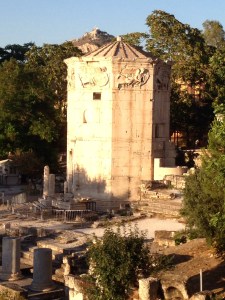
Tower of the Four Winds
Library of Hadrian
Hadrian was the Roman emperor in the 2nd century A.D. who had quite an affection for all things Greek. He had this library and civic center constructed for the Athenians. The building housed gardens, lecture halls, art galleries, and a library. Today, most of what you see is a reconstruction of one wall and a few Corinthian columns.

Library of Hadrian
Monastiraki Square
This is Athen’s second main city square loaded with old world class and style. The big building on the left is the metro station where tw0 train lines connect. From this square one could walk to the Archaeological Museum (1 mile to Omonia Square), feast on souvlaki (the typical Greek meat-on-a-stick fast food), wander into the old town, or or hop on the metro to zip off to far flung areas of town.

Monastiraki Square
By 7 p.m. we had experienced and seen the most important ancient and tourist sights in the Pàlka. Arriving at Monastriki Square and the Metro station, we decided to give the Ancient Agora a go. Following the Metro tracks, we soon came to the main Agora entrance and ticket booth.
Here’s a hint
Avoid long lines at archeological site ticket booths by arriving late in the afternoon. Alternatively, visit a lesser-known site entrance before the Acropolis. Purchase a €12 “strip ticket” for all the archeological sites in Athens including the Acropolis, Agora, Roman Forum, Keremikos Cemetery, Library of Hadrian, Theatre of Dionysus, and the Temple of Olympian Zeus. The ticket is valid for four days, and technically the attendant will tear off one “strip” for each site you visit. However, I did not have any collected except at the Acropolis. IF you purchase your ticket first at the Acropolis, then you’ll receive one ticket with a bar code that will be scanned at each site visited.

The Ancient Agora
Visiting the Ancient Agora during its final hour of the day was a good idea. Although the sun was still high and warm, there were only a few tourists milling around. We were able to see almost all the Agora sites in less than an hour, although it was a push to get up to the Temple of Hephaistos before the attendants began blowing their whistles to alert of the impending closing time of 8:00 p.m.
Temple of Hephaistos
This is one of the most well preserved of all Greek temples. Construction began here in 450 B.C. shortly after the entire Agora was destroyed by the invading Persians (480 B.C.). However, construction work stopped here while the Athenians concentrated on building the temples on the Acropolis, including the Parthenon. The temple is dedicated to Hephaistos, the “blacksmith” god and originally contained bronze statues of he and Athena.

Temple of Hephaistos
The temple was converted to a Christian church in 1300 A.D. and named the Church of St. George (the patron saint of Athens). Because of its continued use, the structure was maintained and kept up resulting in the wonderful condition in which we find it today.
The Agora in 1977
My notes, dated May 5, 1977, mention visiting the Temple of Hephaistos…
I got up at 6:15 am yesterday morning and walked down to the Temple of Zeus and took photos, then went to the Olympic Stadium and Royal Gardens. Doug and I then went and ate breakfast at the hotel. Then took an excursion to the ancient agora and the Theseion/Temple of Hephaistos and agora museum.
Here is the photo my friend Doug snapped of me standing in the temple. I recall back then we were allowed inside the temple and could actually see the ancient frieze in the alcoves depicting mythological battles between the Lapith tribe and a group of centaurs during a wedding feast.

Temple of Hephaistos 1977
Here is a photo Charlotte snapped of me in December 2010 during our visit to Athens. The temple has remained the same, I’ve not! Notice too that I was not allowed on the steps as the entire temple is fenced off.

Temple of Hephaistos 2010
Take the back gate for a speedy exit
We exited the Agora at the “back gate” up the hill in the direction of the Acropolis (Polygnotou “street” on your map). This put us up near the top (Prytaniou street) with great views of the Plàka and Athens to the north and the Acropolis looming just overhead to the south. We experienced a fantastic sunset and later, an almost full moon rising in the west.

Sunset over the Roman Forum
The Plàka is not flat.
It stretches consistently uphill until the slops of the Acropolis makes it impossible to build houses. Consequently, the “streets” are often no more than small cobbled pedestrian paths winding past shops, restaurants, and businesses. The farther uphill one wanders, the more steps and stairs are encountered.
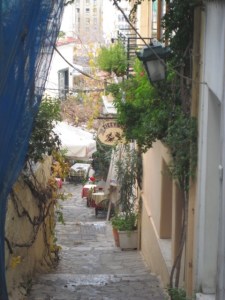
Steps and more steps
One such place, called Mnisikleous, is known for a series of cobbled stairs stretching of 100 yards and lined with trendy restaurants offering good food, decent drinks, ok music, and plenty of ambience.
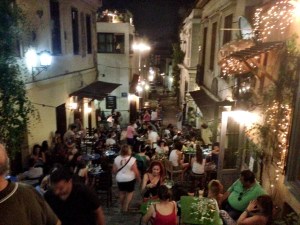
Mnisikleous Street dining
Capping off our day, we chose an outdoor restaurant known for authentic Greek food offered at very reasonable prices. Xenious Zeus is not a secret among tourist in Athens. This restaurant appears in all the guidebooks and is advertised as a place with good food and good prices. Since we were all the way up the hill, I thought we should give it a try.

.
For €12 we got a three-course meal featuring a selection of five Greek appetizers, called mezedes, a main course, and desert. We added a Greek Salad to share between the three of us. For a quick and unpretentious introduction to Greek cuisine, this place can’t be beat.

mezedes sampler
After dinner, we walked back to our hotel with a full moon rising in the west, our bellies full, and our bodies worn out. For me, this was the perfect mix of recovery, sightseeing, and dining to begin our adventures in Greece.
Read my previous post. Read my next post.

by David McGuffin | May 8, 2014 | Blog, Culture & Customs, Daily lfe, Destinations, Experiencing Europe, Holiday
I am smack dab in the middle of my Best of Germany, Austria, Switzerland, and France tour. I picked up a group of just four folks a few days ago in Munich and we’ve had a blast getting to know each other and experiencing Germany and Austria. It being the beginning of spring, we’ve run in to several celebrations dedicated to digging out of the gloomy winter and leaping into spring.

Frühlingfest Munich

Frühlingfest Munich
In Munich, the massive outdoor Octoberfest site was booming with the Frühlingfest. This, a yearly spring celebration seemed very much like our state or county fairs at home with the addition of lots of lederhosen, dirndls, beer, and sausage. As the opening ceremonies began I enjoyed marching bands, horse-drawn beer wagons, and fifty or more ancient pistols being fired into the air in celebration of spring.
While in Salzburg fellow tour members stumbled upon a celebration of the Lord Mayor’s birthday in the Mirabell Gardens complete with fanfare, song, toasting, and celebration. The Augustiner Bräustübe had just switched over to its standard brew, changing from the special Lenten Bier it had served from Ash Wednesday to Easter.

Mirabell Gardens
Driving through Bavaria and the Austria Tirol we encountered lush green fields covered with beautiful wildflowers. Each little village seemed to be trying to outdo the next with its freshly painted and über-Bavaria blue and white maypoles. Even the livestock seem to be extra happy to be out of the barns and into the fields. At times we would encounter field after field of vivid bright yellow rapeseed in full bloom adding to the contrast of the countryside.

Fields of Rapeseed

Tirol
On the morning of May 1st, I watched a crew put up a huge tent and install the 90- foot Maypole topped with a tree and dripping with hanging pretzels. Throughout the morning, locals would drop by to check on the progress, looking up and giving the guy hanging from the Maypole advice and encouragement. Young ladies, clad in traditional dirndls, arrived to set up the tent as a makeshift beer hall while local volunteers laid down wooden walkways and carried all sorts of “potluck” food into the tent. I was sure the celebration would be grand and sort of sorry I was going to miss it.

Maypole in Tirol
Later we arrived in Vaduz, the capital of the Principality of Liechtenstein. Popping out from the underground parking garage it appeared the city was deserted. As I walked toward the main square it became evident that most of the locals were settling in here under a huge tent. The Liechtenstein fire department had all their trucks and equipment out on display. Some of the firemen were in their “dress blues” while others were manning the hot grills loaded with sausages and bratwurst serving lunch to hundreds of people. There was a pair of strolling troubadours, with an accordion and guitar, willing to serenade a table for just a small donation to help the fire department. Nearby, kids were jumping in the bounce house, playing firemen games with water, climbing all over the fire trucks, and getting a ride in the 60-foot “cherrypicker” bucket on the hook-and-ladder truck.

Vaduz Festival
We are in the heart of Switzerland today. The Lauterbrunnen Valley is my favorite alpine spot in all of Europe. I don’t know what today will bring, but I am sure it will be filled with fresh wildflowers in high alpine meadows, snow-capped glaciers, and the gently clanging of bells as the cows are moved from the winter barns to the spring meadows. Everyday is an adventure on an Exploring Europe tour and stumbling upon local celebrations makes travel even more authentic. Why not consider joining one of my tours in the coming months.

Switzerland
Your Adventure Starts Here!

by David McGuffin | Apr 1, 2014 | Blog, Destinations, Experiencing Europe

The Berlin Wall, a 96-mile-long barrier, was erected in stages around West Berlin in 1961. The East Germany government did not call it a barrier or wall, but the “Anti-Fascist Protective Rampart.” Major portions were rapidly constructed, almost overnight, to prevent the constant seepage of people from the East to the West. It is said that close to 3 million people had leaked out between 1949 and 1961. So, by 1961, the East had had enough and built “The Wall” or “Mauer”, as it’s known in German.
The Wall was actually two walls with a patrolled “no man’s–land” in between. The inner wall (on the East German side) was a four-inch thick by 12’ high concrete fence, supported every 8’ or so by steel I-beams. I suppose this type of construction was used so that great lengths of the inner wall could be erected with little effort. Simply install the I-beams in the ground, as posts, and drop the heavy pre-fabricated concrete panel in between.

The outer Wall (located on the West Berlin border) was more substantial. Still constructed of pre-fabricated concrete, this Wall was 12-feet high, about 6” wide, and had a rounded concrete pipe-like top casing to discourage grappling hooks, ladders, and like.

In between these two walls was a “no man’s-land” ranging in distance from 30’ to 150’. This “no man’s-land” was devoid of vegetation, contained a patrol road, lighted by high powered street lamps, and watched over by more than 100 sentry towers containing armed patrol sharp shooters. Additionally, there were hidden trip wires and invisible silent-alarm barriers designed to alert the guards of any movement with the “no man’s-land.” In the photo below, the wooden cross marks a spot in the former “no mans-land” where a victim was shot and killed by East German border guards.

The intact portion of the Wall stretches for four of five blocks along Bernauer Strasse from the Nordbahnhof Station. As with everything else in Berlin, the Wall Memorial is under construction and some portions of the outside exhibits are not complete. However, there was enough signage, placards, and photos to hold my interest for three hours along this stretch of the Wall. One of the outdoor exhibits contained photographs of the 136 people who were killed at the Wall while trying to escape.

During the Wall’s 28 years, it is documented that border guards fired 1,693 times and made 3,221 arrests. There were 5,043 documented successful escapes. About 10% of these escapes were East German border guards sneaking off to the West.

Visiting this site gave me a “hands-on” understand of just what this Cold War and Socialist division between East and West was all about. It was not until I walked the Wall, surveyed the city-scape on either side, and read accounts of “life behind the Wall” that I fully realized what the horror of being “fenced in” must really be like.
 Subscribe to my blog so that each time I post you will receive a notification.
Subscribe to my blog so that each time I post you will receive a notification.

by David McGuffin | Mar 30, 2014 | Blog, Destinations, Experiencing Europe
 From early in my life, I had heard stories about The Cold War, East Germany, and the East and West Berlin separation. I recall my uncle, a U.S. Army officer, telling stories about his adventures while stationed in Germany in the 1950’s. Later, his son (my cousin Bobby) was stationed in Berlin at the time the wall fell in 1989. I remember talking with Bobby at one of our reunions about the simultaneous jubilation and discord in those early November days in 1989. But I had always had this sense of trepidation and unease when it came to traveling to former Communist countries. So, I never took the opportunity to explore to the “east.”
From early in my life, I had heard stories about The Cold War, East Germany, and the East and West Berlin separation. I recall my uncle, a U.S. Army officer, telling stories about his adventures while stationed in Germany in the 1950’s. Later, his son (my cousin Bobby) was stationed in Berlin at the time the wall fell in 1989. I remember talking with Bobby at one of our reunions about the simultaneous jubilation and discord in those early November days in 1989. But I had always had this sense of trepidation and unease when it came to traveling to former Communist countries. So, I never took the opportunity to explore to the “east.”
Even with all my travels, I had never visited Berlin… until today. I boarded the ICE high-speed train in Hamburg. At speeds up to 218 kph, was transported to Berlin in just over one hour and thirty minutes. Not being in a rush, I took my time in the Hauptbanhof train station. I even sat down with a Starbucks coffee and my guidebook to get a feel for the city. After walking out the wrong side of the station, checking my bearings with “Google Maps”, and readjusting my course, I struck off down Invaliden Strasse into the former East Berlin. I was immediately faced with detours and construction on the street and sidewalks causing me to cross from one side of the street to the other. However, with a little persistence, I managed to navigate the stretch to my hotel in about thirty minutes.

Berlin’s Hauptbahnhof
My hotel is wonderful! Recently, I’ve been using booking.com to research and book my hotels. The “Hotel i-31Botique Hotel” has 113 brand new and modern rooms with all the perks.

After chatting with the front desk clerk, I learned the “Berlin Wall Memorial” was just 200 meters behind the hotel. So, after settling in to my room, I ditched my bags and went out to explore the “Berlin Wall” all of which I will share with you in my next blog entry.
 Subscribe to my blog so that each time I post, you will get a notification.
Subscribe to my blog so that each time I post, you will get a notification.


















































